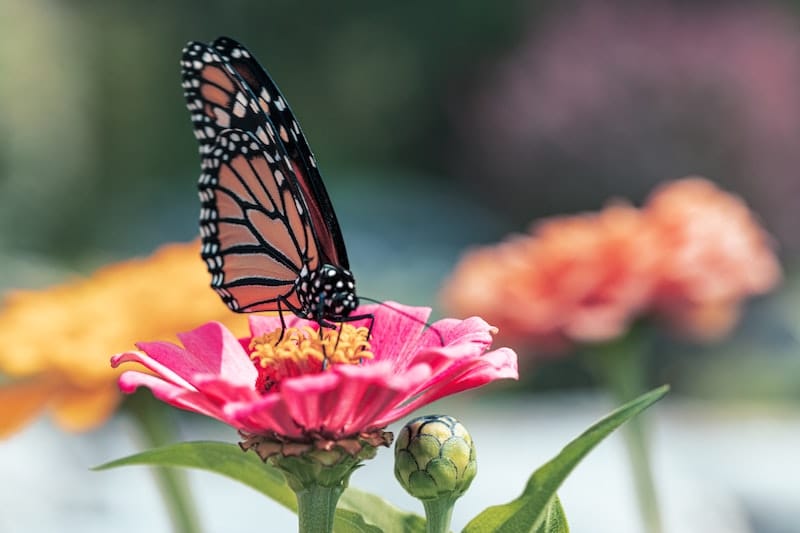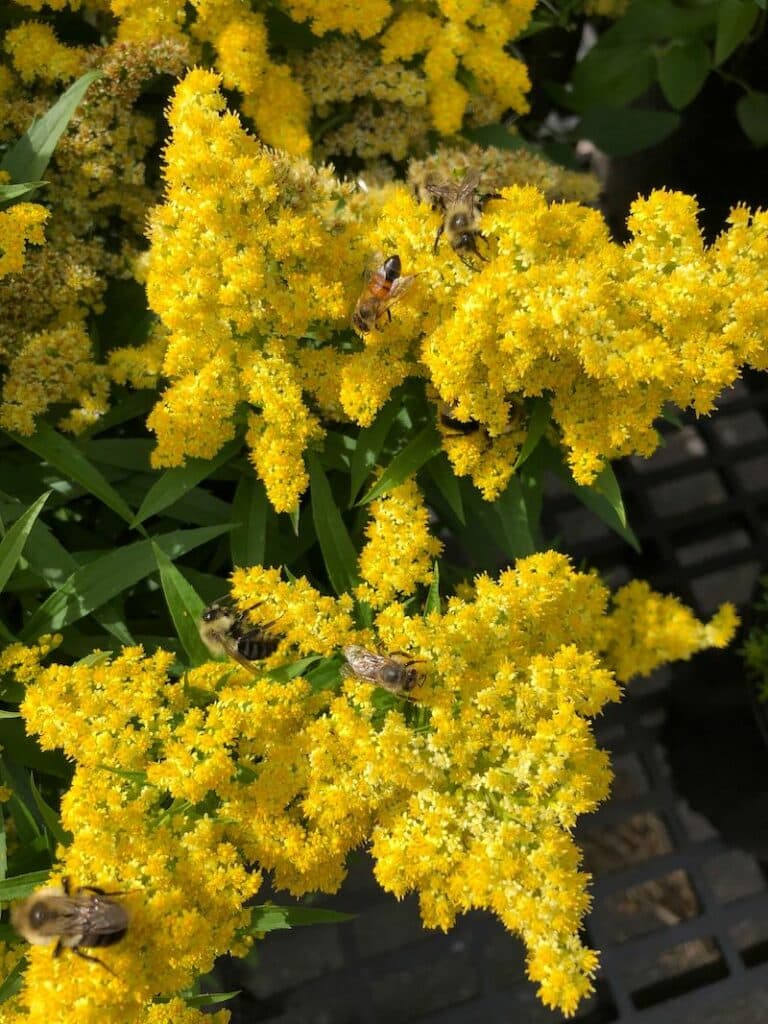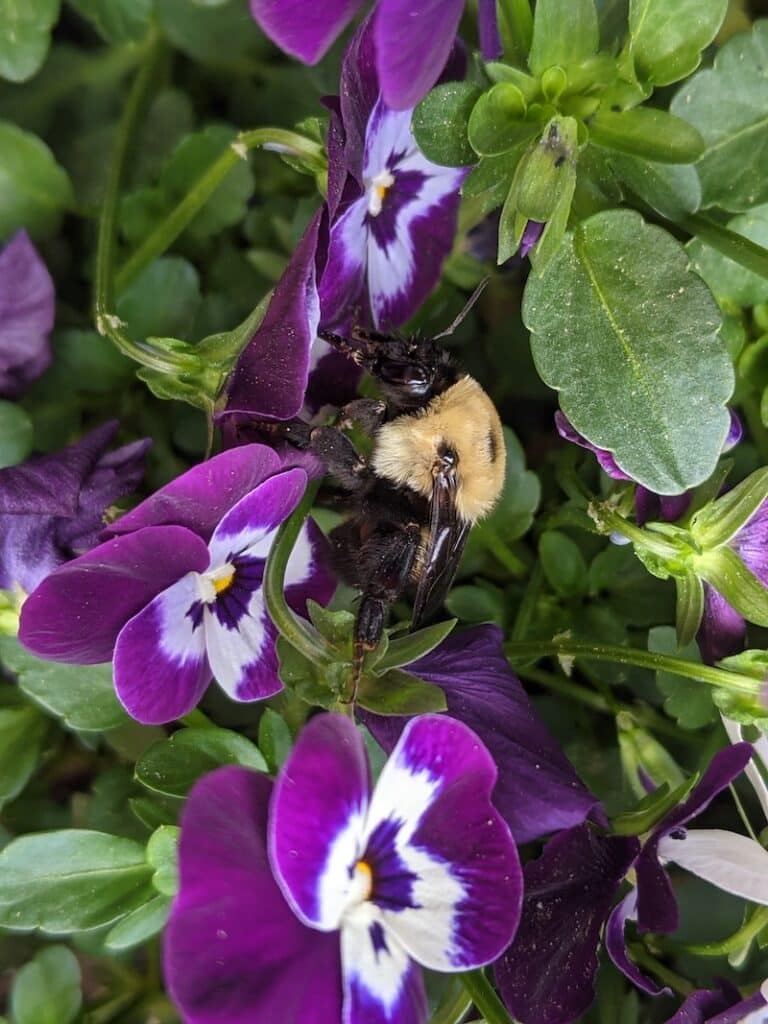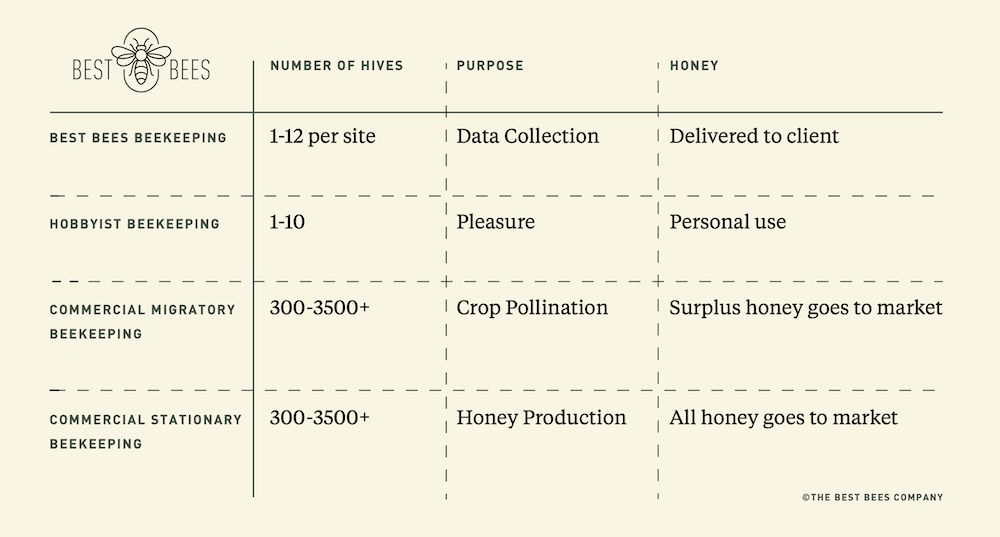Contents:
-
- What are Native Pollinators?
- Types of Native Pollinators
- Why are Native Pollinators Important?
- North America’s Important Native Bees
- Other Important Native Pollinators in North America
- Threats to Native Pollinators
- How to Help Native Pollinators
- Attracting Native Pollinators
- How Best Bees Supports Native Pollinators
- Native Pollinator FAQ’s
What Are Native Pollinators?
All animals such as bees, birds, and butterflies have coevolved with plants to form symbiotic relationships. In these partnerships, some animals collected nectar and pollen as food. Over time some animals came to transfer pollen between plants, helping them to reproduce by spreading pollen between flowers. “Native” pollinators are those animals that have evolved alongside plants in one area—which could be as small as a few square miles, or as large as a continent—and so are extremely well adapted to the reproductive needs of their native plant species.
Plants have evolved unique ways to attract pollinators through scent, color, flower shape and nectar placement, and pollinators have responded in kind. Hummingbirds are attracted to hot colors, especially red flowers, and their tongues are particularly adept at extracting nectar from long, tubular flowers. Bees are attracted to cooler colored flowers, especially blues, purples and even ultraviolet, which we humans can’t see.. While most pollinators are generalists, some have evolved to become highly specialized, such as squash bees, blueberry bees and sunflower bees, that spend most of their time pollinating flowers in their namesake families.
Types of Native Pollinators
Worldwide there are over 200,000 different species of pollinators, including bats, bees, beetles, birds, butterflies, flies, moths, small mammals, and wasps.
Two of the most widely recognized native pollinators to North America are hummingbirds and monarch butterflies. Both species are found only in the western hemisphere. Other less well-known but common native pollinators are bumble, carpenter, & mason bees, leaf and sap beetles, sphynx moths and a host of butterflies such swallowtails, sulphurs and whites.
With the widespread movement of peoples and trade over the past five centuries, what constitutes the norm for plant/pollinator partnerships has changed significantly. We might think of a continuum of existence, including native, established, non-native and invasive. Honeybees and paper wasps, native to Africa, Asia, and Europe, were brought to North America 400 years ago, and have become an established and essential part of our food system, accounting for more than $20 billion in the U.S. alone. Some non-native species, such giant “murder” hornets, are invasive, and through predation on native pollinators and honeybees, pose a threat to our food system and our environment.
Why Are Native Pollinators Important?
Pollinators are what keep our world green, and a green world is essential to the survival of mankind and all life on our planet. Almost 90% of plants rely on pollinators for reproduction. It’s commonly estimated that three out of four bites of food eaten each day are available to us because of pollinators. Wild native pollinators play a critical role in this as they’re uniquely adapted to pollinating native species of plants. Preserving native plants is essential to maintaining species diversity and the healthy web of life that diversity assures.
North America’s Important Native Bees
There are roughly 20,000 species of bees in the world, of which 20%, or 4,000 species, are native to North America. Unlike honeybees which can live in large colonies of 50,000 or more, and bumble bees, which typically form nests of 50-500, most native bees in North America are solitary. Because of their low key nature, these bees have been poorly studied, and less understood than their highly social sister bee species
Some common bees native to North America are blueberry bees, bumblebees, digger bees, leaf-cutter bees, mason bees, miner bees and squash bees..
Bumble bees have a unique approach to foraging called buzz pollination, or sonication. They grab the flower’s pollen-bearing anthers with their mandibles, decouple their wings, and activate their flight muscles. This transfers the vibration to the anthers, shaking the pollen in a “salt and pepper shaker” like mechanism onto their bodies—something that honeybees cannot do. Several important crops native to the Americas—blueberries, cranberries, peppers, and tomatoes—are pollinated primarily by native pollinators like bumblebees that have evolved to employ this technique. Recent research has shown that bumblebees can alter the frequency of their sonication in response to plant types and weather conditions.
Other Important Native Pollinators in North America
Bats. Some native bat species are frugivorous and nectivorous, meaning they eat fruit and nectar, and through nectar foraging, help with pollination. Crops grown in the southwest and west, where there’s a high concentration of bat species, rely on bats for pollination. These include native agaves, and non-native avocados, bananas, cashews, dates, guavas, mangos, and peaches.
Beetles. Beetles may be the oldest of pollinators, dating back to the early days of flowering plants. There aren’t many native species in North America that depend on beetles for pollination, and those that do usually are characterized by strong scents. Two species that depend on beetles for pollination are magnolias and water lilies, descendants of early cycads, an ancient group of plants once a prominent part of the floral ecosystem.
Birds. While insect-eating birds can accidentally assist with pollination when they land to take insects off flowers, it’s nectar-eating birds that are the true pollinators of the avian world. In North America, hummingbirds are the best example of birds that have coevolved with plants, developing long tongues that draw nectar from tubular flowers such as beebalm, lobelia, red buckeye, and turtleheads.
Butterflies. There are 700+ species of butterflies native to North America. Butterflies are attracted to colorful, scented flowers, with open, relatively flat faces that are easy for them to land on. Native plants pollinated by butterflies include such as common wildflowers as asters, coneflowers, daisies, thistle, and yarrow.
Flies. A number of fly species are nectar-eaters; some have evolved to mimic the look and shape of bees or wasps as a form of protection from predators. One of the most important native species is known as the hoverfly and is an important pollinator of fruits such as apples, pears, cherries, plums, apricots, peaches, strawberries, raspberries, and blackberries. To attract fly pollinators, some native plants such as Jack-in-the-pulpits, pawpaws, skunk cabbage and trillium, have evolved putrid odors similar to rotting meat.
Moths. While moths have long been recognized as important pollinators of night-blooming plant species, recent research suggests that they may pollinate a wider range of flowers than honeybees. Native moths help to pollinate native plant species ignored by honeybees.
Wasps. While less efficient pollinators (they have less hair on their bodies for pollen to stick to), they can be important pollinators as they often visit plants that bees ignore. Plants that are attractive to wasps tend to be dull, odorous, and have nectar that’s easy for them to access. Two plants that can depend on wasps for pollination are figs and orchids.
Threats to Native Pollinators
Pollinators—both native and non-native—face a myriad of threats, including habitat loss, climate change, pollution, unsustainable agricultural practices, the widespread use of toxic fertilizers & pesticides, diseases, as well as attack by invasive pests, parasites & predators.
There are some in the scientific community who’ve expressed concern that honeybees, where large populations exist, could be contributing to the decline in native pollinators. Recent studies on this are mixed: some, such as Competition between Exotic Honey Bees (Apis mellifera) and Native Pollinators on Late-blooming Desert Scrub by J. Osteen, A. Necarsulmer, J. Fan Brown and N. Nguyen, and Impact of Invasive Bees on Plant-Pollinator Interactions and Reproductive Success of Plant Species in Mixed Nothofagus antarctica Forests by J. Aguer, N. Perez-Mendez, J Torretta and L. Garibaldi, show little or no effect on native pollinators, while others, such as Honeybees disrupt the structure and functionality of plant-pollinator networks, by A. Valido, M. Rodriguez-Rodriguez and P. Jordano, and Honey Bees and Wild Pollinators Differ in Their Preference for and Use of Introduced Floral Resources, by C. Urbanowicz, P. Muniz and S. McArt show, where there are limited flowers such as arid desert habitats, that competition with honeybees can lead to noticeable reductions in native bee populations.
Of all the factors negatively impacting native and non-native pollinators, the most persistent and dangerous is the on-going loss of habitat. Since Europeans first came to North America, we’ve been altering the landscape to serve the needs of mankind at the expense of the natural world. Deforestation, industrialized agriculture, urbanization, and suburban sprawl have led to a massive loss of habitat, and with habitat, sources of food for pollinators of all types. This has been especially hard on native pollinators, as habitat has led to a marked loss of indigenous plant species native pollinators depend on.
One rarely discussed but potentially dangerous factor is misinformation. Without a deep understanding of the facts, it’s easy to be led to the wrong conclusions, and actions that could make the situation worse, rather than better, for both native and non-native pollinators. At Best Bees, we believe a scientific approach is essential, and are working with professional and citizen scientists to study pollinators and test and measure solutions to improve their health and survival.
How to Help Native Pollinators
At Best Bees, we believe that habitat protection and restoration are critical to pollinator health. Moving to sustainable agricultural practices and turning gray cities green, with an emphasis on planting and nurturing native plant species, will create a virtuous circle where all pollinators—native and and long-established alike—can thrive.
Native pollinators have two basic habitat needs: green spaces where they can forage for food, and environments where they can nest.
If you own or manage a commercial or multi-unit residential property, think about landscaping at both ground and rooftop with plant materials that are native pollinator friendly. While outdoor ground space may be limited, most roofs are overlooked, and rooftop pollinator gardens are a win on many levels: they provide nourishment for pollinators, offer food and aesthetic enjoyment for tenants and guests, improve property values, and help with LEED certification.
Homeowners and renters can help too. Regardless of the space available to you—a city window box or a large suburban yard—growing flowering native plant species will provide much-needed nourishment to pollinators. Avoid herbicides and pesticides—these weaken and kill pollinators.
Another way to help native pollinators is by installing “bee hotels”–these are small structures made of tubes of organic materials (usually wood or bamboo) that some solitary native bees use for nesting. Look for models that allow you to clean or replace the tubes annually so as to prevent disease. You can find them at most garden centers. Crown Bees (https://crownbees.co) is our favorite online retailer for these.Those with a variety of tube size and depth are best, as they’ll appeal to a wide range of native bees. Other native pollinators are ground nesters, so try to leave some areas of ground cover—leaves, twigs, and bare soil, even old field mice nests—undisturbed for them to nest in.
We can all help native pollinators by becoming citizen scientists. Recording pollinator activity you’ve seen at sites like The Great Sunflower Project https://www.greatsunflower.org and Bumble Bee Watch https://www.bumblebeewatch.org helps professional scientists gather data on the number and location of different native pollinator species. Get friends and coworkers involved with you, by hosting a Beeblitz through The Bee Conservancy https://thebeeconservancy.org/host-a-beeblitz/. If you’re into photography, you can post photos you’ve taken of native pollinators in action at https://www.projectnoah.org. Want help identifying native pollinators? Get the Wild Bee ID app: https://www.wildbeeid.org/get-the-app
Attracting Native Pollinators
The best way to attract and nourish native pollinators is for us all to grow native plant species. While generalist pollinators will benefit from both native and non-native plants, specialist pollinators need native plants for their survival. With habitat loss, these are the most vulnerable species.
When choosing plants, keep in mind that perennials usually provide more nourishment than annuals, and single-flowering varieties are much better for pollinators than doubles, as the proliferation of petals in doubles (think big peonies and roses) makes their nectar and pollen hard to reach. Plant as wide a variety of species as you can, as diversity will help feed a range of native pollinators and try to have something blooming throughout your local growing season to provide on-going nourishment.
Your state conservation department can help you with plant selection, as can the Audubon Society and the National Wildlife Federation.
How Best Bees Supports Native Pollinators
At Best Bees our mission is to improve bee health, expand bee populations, and contribute to the creation of truly sustainable environments. We began our operations in 2010 working solely with honeybees, but quickly concluded that the larger web of life they are a part of is under stress from a host of factors, including environmental degradation, habitat loss, and climate change, and that no solution for honeybees could have lasting impact without consideration of how they relate to plant and animal species around them. Today, our work, while still focused on honeybees, includes a growing engagement with other pollinators, especially native bees.
Our primary contribution to pollinators—both native and introduced species—is through the collection of data on bees and the scientific study of bee health. Over the past decade we’ve amassed the largest database on honeybees using standardized beekeeping practices in North America, and through our affiliated non-profit, the Urban Bee Laboratory, we analyze these data, track changes over time, measure results of tests, and share our findings with the public as well as with leading scientific organizations such as MIT, NASA, National Geographic, and TED.
While it would be ideal to closely monitor all species of pollinators, honeybees, living in large colonies managed by us, are easy to monitor, whereas solitary native bees, living in the wild, are not. To us, honeybees are a perfect indicator species, and the learning we gain about them is helping make decisions that benefit all pollinators, native species included.
Our study of honey DNA is a great example. The forensic DNA tests we perform on thousands of hives is giving us in-depth understanding of plant environments and where bees are finding nourishment. Coupling these findings with those of partner organizations studying animal DNA found on flowering plants, we’ll have, for the first time, a comprehensive picture of pollinators of all kinds and the plants they are pollinating. Our next phase of this project involves actively planting those plants found in hneyDNA, and sampling all the animal DNA found on those flowers to reveal exactly which hidden pollinators are visiting. This is how we will measure biodiversity impact. This information will inform everyone on what species to plant to help us rebuild healthy populations of honeybees and native pollinators.
We believe strongly that pollinator survival is not a zero-sum gain. What helps honeybees will help native pollinators, and vice versa. Because everything is rooted in data collection to advance our understanding of pollinator ecology, at the local level where our client sites are. One role we play is to make people aware of the issues facing pollinators and through honest and open discussion, find solutions that benefit all.
Native Pollinator FAQ’s
Q: What are native pollinators?
A: Native pollinators are those animals (insects, birds, and small mammals) that have evolved a symbiotic relationship with flowering plants, where the animals derive nourishment from plant nectar and pollen, and through transfer of pollen within and between plants, help plants to reproduce. Native can refer to a section of the country or a whole continent. White shouldered bumblebees are found largely west of the Rocky Mountains, honeybees, an introduced, established and agriculturally-required species in North America, are native to Africa, Asia, and Europe.
Q: Where are native pollinators found?
A: More than 75% of terrestrial flowering plants depend on pollinators to reproduce, and so native pollinators exist in virtually every environment where plants are found, from deserts to rain forest, from highly urbanized areas to wild woodlands.
Q: Do native pollinators help pollinate food crops?
A: While honeybees are the best-known pollinators of fruits, vegetables and nuts, native pollinators can play an important role as well. In the case of some fruits and vegetables native to the Americas, such as cranberries, blueberries, peppers and tomatoes, native insects are the primary pollinators.
Q: Are native pollinators endangered?
A: Because of habitat loss, pollution, and the widespread use of pesticides and herbicides in industrial agriculture, populations of all pollinators are in decline. Many native bees and butterflies are at risk. Only one bee species is considered endangered–the rusty-patched bumble bee. Some species, such as Western Monarch Butterflies, have seen reductions of over 90% in the past four decades.
Q: Are honeybees a threat to native pollinators?
A: While introduced pollinator species, such as honeybees, can compete with native pollinators for food where floral resources are scarce, there is little evidence that this competition is a significant factor contributing to native pollinator decline. Rather, having more pollinators in a given areas is more likely to lead to more pollination, and proliferation of those plants that support pollinator foraging.In Africa, Asia, and Europe, where honeybees are native, they have coexisted with a host of other pollinator species for millennia.
So far, concerns that urban honeybees might be crowding out native bees are unfounded, and something our science team is actively monitoring, and staying up-to-date on.. Studies on the impact of honeybee/native bee competition have had mixed results: some studies showed no impact on native bees, some a slight-to-moderate decline due to limitations in available plants for foraging. The real culprit in pollinator decline is lack of habitat—with more parks, backyard, balcony and rooftop gardens, and as much as eight times greater species richness, urban areas can support robust populations of both native pollinators and honeybees.
Q: What can I do to help native pollinators?
A: There are four ways each of us can help native pollinators: 1) grow more flowering trees, shrubs and plants, especially native species that attract native pollinators; 2) provide nesting habitat for native pollinators (undisturbed ground and/or “bee hotels”; 3) join the citizen scientist movement that is helping collect data on pollinators www.greatsunflower.org; 4) advocate for more green space with native species in you state and municipality.
*Blog Featured Photo by amy lynn grover on Unsplash









